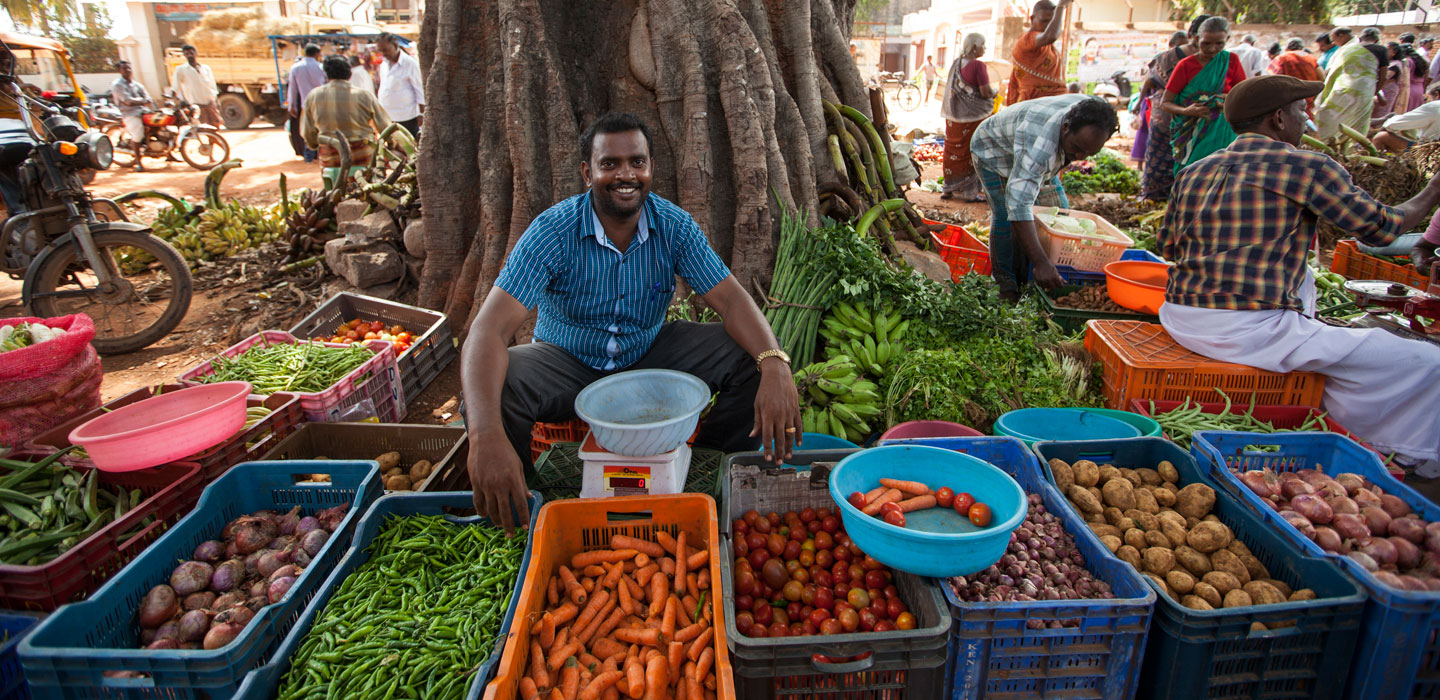العائدون إلى الوطن: الهجرة والاستجابة لجائحة كوفيد-19 في الهند
IFAD Asset Request Portlet
ناشر الأصول
العائدون إلى الوطن: الهجرة والاستجابة لجائحة كوفيد-19 في الهند
المقدر للقراءة دقيقة 7
©IFAD/Susan Beccio
في ظل تدابير الحماية المتخذة في معظم أرجاء العالم بسبب جائحة فيروس كورونا المستجد (كوفيد-19)، تشير تقديرات منظمة العمل الدولية إلى حوالي 2.7 مليار شخص - 81 في المائة من القوة العاملة في العالم - متضررين حالياً من إغلاق أماكن العمل كلياً أو جزئياً. وتتسابق الحكومات إلى التخفيف من المعاناة الاقتصادية الناشئة عن ذلك والتي تُهدِّد بالزج بحوالي 49 مليون شخص على نطاق العالم إلى هوة الفقر المدقع ومفاقمة الجوع العالمي. وأكثر المتضررين هم العاملون في القطاع غير الرسمي، كما أن المهاجرين معرضون بشكل خاص للآثار الناجمة عن تلك الظروف. ويعمل ثلاثون في المائة من مهاجري الهند البالغ عددهم 450 مليون مهاجر في القطاع غير الرسمي، وهم ليسوا استثناءً.
وعندما أعلنت حكومة الهند فرض إغلاق وطني، قرر كثير من العمال المهاجرين العودة إلى بلادهم مدفوعين إلى ذلك بعدم التيقن والارتباك في ظل تضاؤل دخلهم. وكان الأمل يراودهم بأنهم عندما سيعودون إلى قراهم الأصلية سيتمكنون من الحصول على وجبات منتظمة ودخل زراعي وبرامج حماية اجتماعية في نفس الوقت الذي سيوفرون فيه نفقات مثل الإيجار الشهري. وبصرف النظر عن المخاوف من أن تؤدي عودتهم إلى تفشي المرض في المناطق الريفية من الهند فإن هذا النزوح الفجائي من المدن أدى أيضاً إلى حالة طوارئ مختلفة اضطرت فيها الحكومة على جميع مستوياتها إلى التدافع لعزل العائدين والمهاجرين العالقين على نحو آمن وإنساني.
وحتى مع إقامة منازل للإيواء ومخيمات للإغاثة لدعم حوالي 10 ملايين من المهاجرين العالقين في جميع أنحاء البلد، لم يتمكن كثيرون منهم من العودة إلى قراهم - ولم تكن مجتمعات محلية كثيرة مستعدة تماماً لاستقبالهم. وهنا ظهرت في صدارة المشهد المؤسسات المجتمعية المحلية التي كان لها دور حاسم في الاستجابة للجائحة لإكمال الميل الأخير من تبديد مخاوف العدوى بين السكان المحليين وتحقيق التوازن بين احتياجات الصحة العامة والرغبة المفهومة لدى أفراد الأسرة في التئام الشمل، والعمل مع الإدارات المحلية لوضع ترتيبات مريحة - ومتوافقة مع المتطلبات التي تقتضيها جائحة كوفيد-19 - لإيواء ورعاية المهاجرين العائدين.
وتوالت التقارير من جميع أنحاء الهند حول الطريقة التي هبت بها تلك المؤسسات التي أنشئت على يد الفقراء ومن أجلهم لخدمة المهاجرين العائدين في تلك المحنة. ولم يقتصر هذا الدعم على نشاط واحد في بعض أنحاء البلد النائية الأكثر بعداً التي يعمل فيها الصندوق مع الحكومة لتحسين حياة السكان الريفيين وسُبل كسب معيشتهم.
وفي ولاية جارخاند، على سبيل المثال، عملت جماعات العون الذاتي التي تشكلت كجزء من مشروع التمكين القبلي وسُبل العيش في جارخاند، (village-level elected governments) to prepare quarantine centres, as is the case in neighbouring Odisha. Also in Odisha, project staff and beneficiaries are providing cooked meals to vulnerable populations, such as pregnant women, the poor and migrants under quarantine. In Maharashtra, the SHGs affiliated with Mahila Arthik Vikas Mahamandal, IFAD’s implementing partner for the Tejaswini project, are supporting the state government’s Shiv bhojan thali scheme to provide pre-cooked meals to migrants and daily wage earners in need. In Nagaland, beneficiaries and lead farmers of another IFAD-supported project, FOCUS, are setting up community kitchens. Meanwhile, the livelihood collectives in Uttarakhand (part of the Integrated Livelihoods Support Project) are not just cooking for migrants – they are also assessing their needs and helping them access various government schemes. This includes collecting daily essentials from their members and distributing them to migrants in need, a practice also seen in Odisha.
These institutions are also raising awareness through information and education campaigns. For instance, community resource persons engaged by an IFAD-supported project in Odisha have been instrumental in spreading awareness on health, sanitation and social distancing, in close collaboration with public health workers. Jharkhand’s community resource persons are also using an app developed by the project to map the risk of COVID-19 at the village level, particularly in villages with greater numbers of returnee migrants. The app is available in five districts across the state.
Though these responses have shown how local community institutions can successfully address the immediate needs of migrants and their communities, these measures are short-term at best. Many questions remain about what will happen once restrictions are eased. For example, nearly 10 per cent of rural households rely on domestic remittances. If migration patterns are significantly altered, will those households be able to find other means to plug the gap? Another challenge is the impact of limited out-migration and subsequent disruptions in supply chains on the rural economy and agriculture. In some parts of the country, farmers are already worried about the potential shortage of agricultural labour during harvest season.
Recently, the Government of India issued guidelines allowing stranded migrant workers to return home. While this presents huge challenges for the government to manage their safe return, it is also an opportunity for community institutions to continue to work closely with local authorities and assist in the careful and gradual assimilation of returnee migrants.
Governments, civil society, the private sector and UN agencies – including IFAD – are working at multiple levels to find medium- and long-term solutions that can address the health-related, social and economic challenges posed by this unprecedented crisis. In many states, the government is undertaking large-scale surveys of migrants to assess their interest, skill sets and future plans. Irrespective of the results, experience from IFAD-supported projects suggests that it will be critical to engage local community institutions – whether in the form of SHGs, livelihood collectives, farmers’ organizations, producer groups or something else – for both immediate relief and longer-term socio-economic reintegration of migrants.
Learn more about IFAD’s work in India.
Read more about IFAD’s response to COVID-19.
تاريخ النشر: 06 مايو 2020
